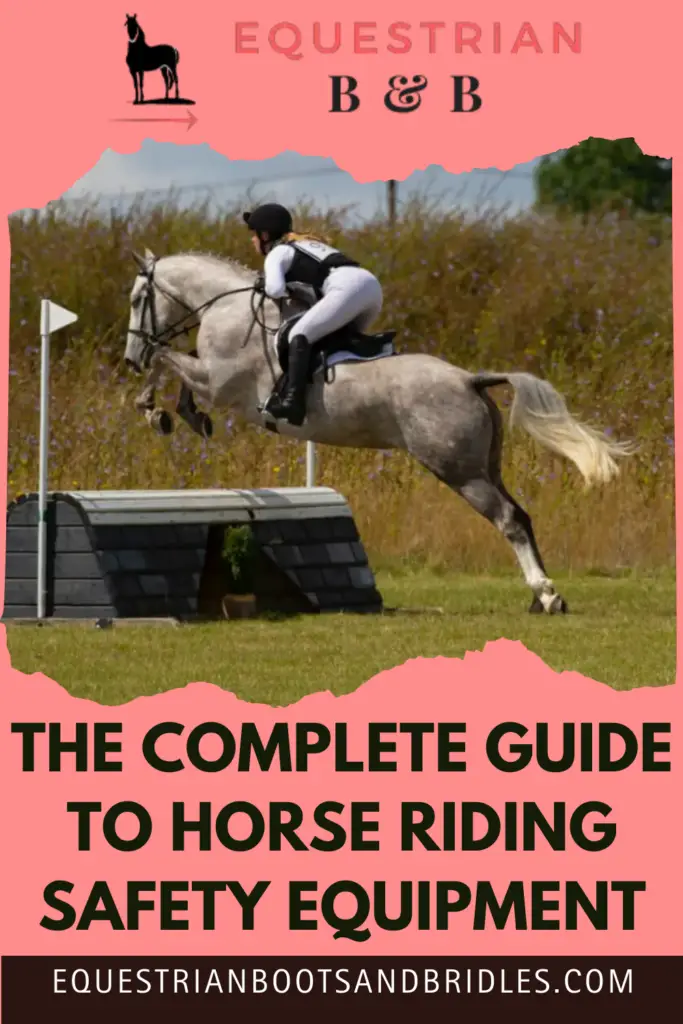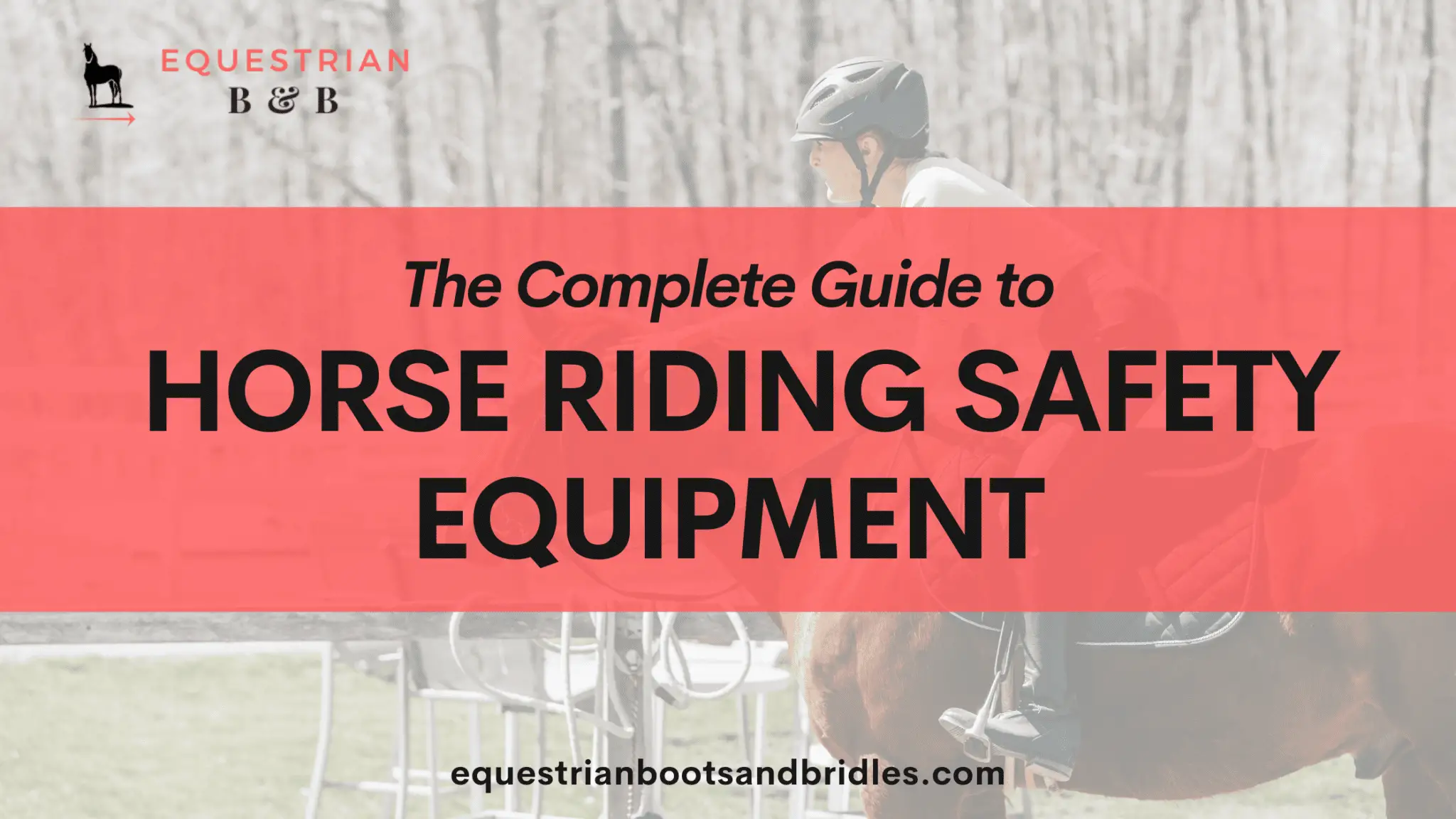Let’s face it—the ground is hard! Falling is a painful event, and if you fall badly, you could suffer serious injury. You may even be unable to ride again, which is any equestrian’s worst nightmare.
When you participate in high-impact equestrian sports like an eventing competition, a severe fall can even lead to death. Riding isn’t for the weak at heart (or body!). But the risk can be mitigated by wearing correct horse riding safety equipment that includes a helmet, body protector, safety vest, and more.
If you’ve been the type of gal or guy to just hop on your horse and blaze into the sunset with your hair in the wind, then you may have never worn any safety equipment (and no, your cowboy hat doesn’t count). But that doesn’t mean it’s too late to start implementing the proper horse riding safety equipment!
It can be pretty confusing when you start looking at safety equipment for horse riding. Unlike an inexpensive set of gloves, horse riding safety vests and other safety items are not cheap. But, I’ve put together your complete guide on which horse riding safety equipment you should get, why you should get it, and how it can make a huge difference to your riding safety and enjoyment.
This article contains affiliate links, which means we may earn a commission if you decide to make a purchase (at no extra cost to you).
What Is Horse Riding Safety Equipment?
Safety equipment is basically any item that helps protect you when you fall from your horse. Nothing can prevent you from falling, but with the right equipment, you can prevent or minimize injury when you do fall off.
I recall my first fall with my air vest and I am an absolute believer in air vests now. As I realized I was going to fall off my horse at high speed, I remember thinking it was going to hurt, and I may not get up from the fall. Then I heard a hiss as the air vest deployed, felt cold, and then felt nothing.
The vest successfully deployed and I suffered only a few scrapes and scratches on my arms and legs, but my back, hips, and neck were completely protected. What a confidence boost!
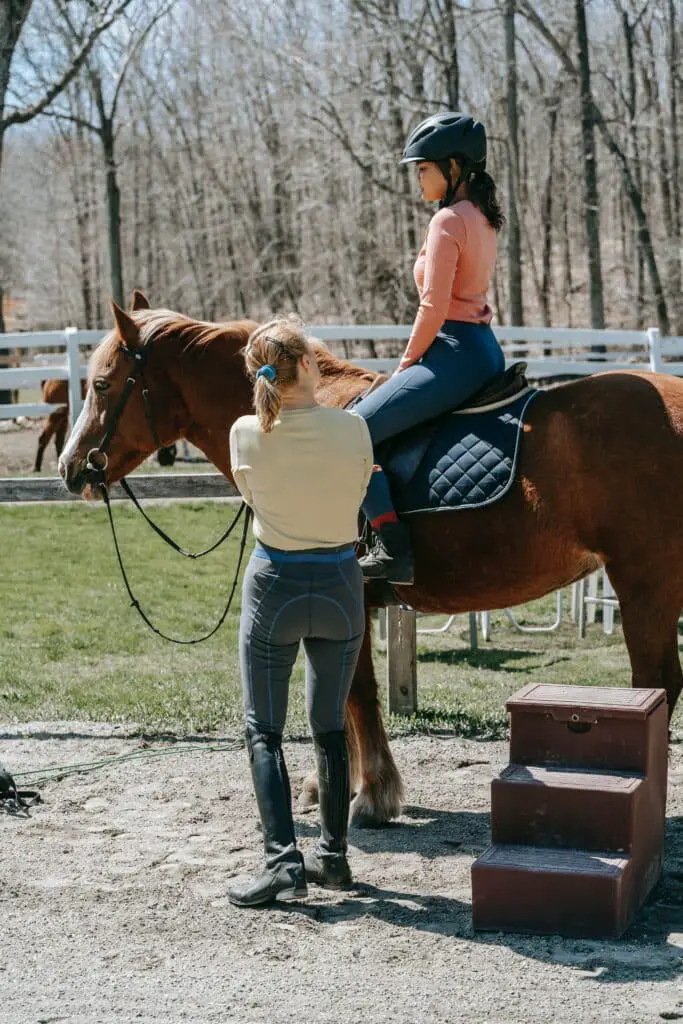
Types of Horse Riding Safety Equipment
In general, horse riding safety equipment includes:
- A Hard Reinforced Helmet
Your helmet is the most important part of horse riding safety equipment. It should have a sufficient safety rating, such as by the British Equestrian Trade Association (BETA). There are many different types of riding helmets, and while these are often seen as a fashion accessory (with some even having Swarovski crystals and bling patterns!), helmets are the first line of defense against head injuries.
This article is mostly going to focus on body protectors and riding vests, but without a good quality helmet, your vest might not benefit you much at all. (You can check out this article for recommendations on the best helmets.)
- Body Protectors
Body protectors come in different ratings according to the type of equestrian sport you participate in. Some have reinforced supports for your spine, hips, and neck, while others are thickly padded to minimize impact.
- Air Vests
An air vest is a unique body and spinal protective device that fits as a loose vest with a lanyard trigger that attaches to a harness on the saddle. When the rider falls off, the lanyard trigger snaps, releasing compressed CO2 from an air canister into the vest’s chambers, creating an air cushion, (much like an airbag in a car).
The rider has a soft, supported landing on the air cushion, with their spine and core structure kept in a safe position from serious injury, even if a horse lands on the rider.
- Riding Boots
While riding boots may not seem to be part of safety equipment for horse riding, a good set of riding boots can help prevent pinching, bruising, and even twisted ankles when a rider falls.
The Ins and Outs of Safety Equipment for Horse Riders
There are many different types of body protectors, helmets, and other protective gear, and no two types are the same. Your specific riding situations and sports will determine what type of body protector or safety vest is best for your needs.
Let’s talk about the different types of body protectors and then I’ll tell you which brands I recommend.
Body Protectors: What, Why, and How
The basic soft-shell body protector is a tight-fitting vest that is padded across the rider’s shoulders, spine, kidneys, and ribs. When the rider falls, or if the horse should step on them, the rider’s vital organs are protected. Traditionally, this type of protective riding vest was worn by jockeys who ride at high speeds.
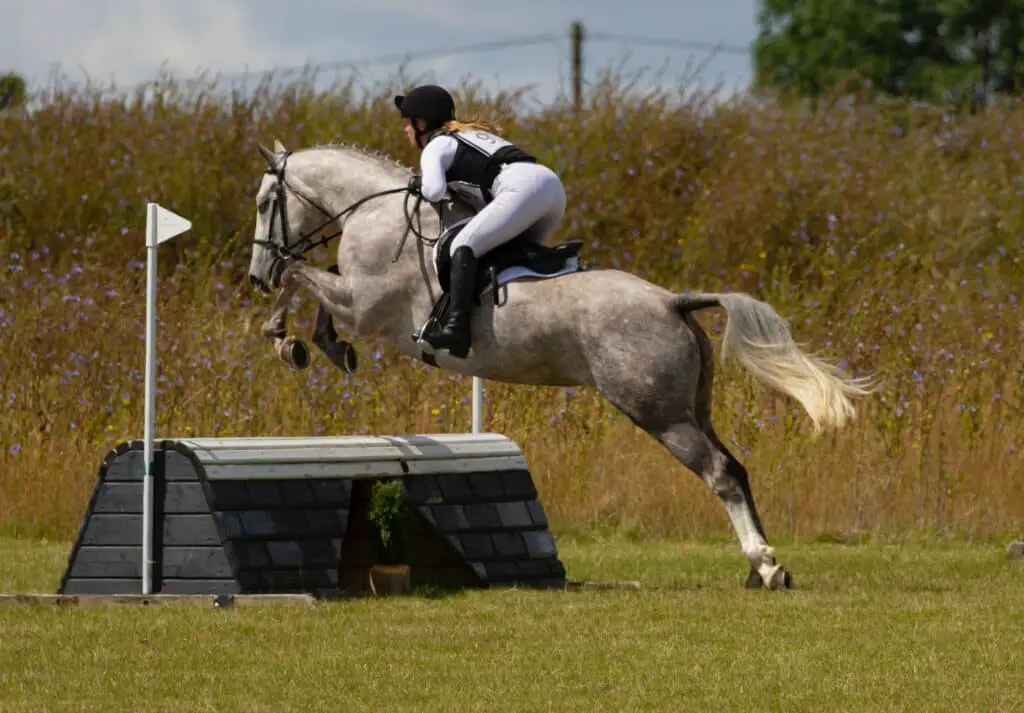
Soft Shell Body Protector Vests
Riders enjoy this kind of vest when riding the cross country portion of eventing classes, low level jumping, and even when trail riding. When using a soft shell body protector during an eventing class, it is best to also wear an air vest for high impact falls and additional protection.
The benefit of a soft shell body protector is that it can be worn under formal riding jackets for a little extra protection, making it ideal for hunter riders, dressage riders, and in the show ring.
Hard Shell Body Protector Vests
The hard shell body protector is designed for when the rider hits the ground with severe force, such as during rodeo, the cross country portion of races, and for jumping. The hard shell body protector is ideal for riders who require a more advanced level of protection.
Riders who frequently work with young horses, where being bucked off is a real risk, often wear a hard shell armadillo type body protector to decrease their risk of internal damage when they fall.
Air Vests: The How and Why of an Air Deployment System
The first air vest was developed by a company started by Christopher Reeve. The actor suffered a serious fall during a show jumping competition where he fell from his horse and severed his spinal column. He was paralyzed for life as a result.
So, the Hit-Air vests were designed to prevent other riders suffering the same type of catastrophic injuries and ensure they could continue doing what they love—riding.
The basic principle of these vests is similar to that of an air bag in a car. The vest fits loosely with several bags inside that inflate when the canister of CO2 is punctured. A fall rips the lanyard and triggers the spike that pierces the canister. The lanyard is attached to the saddle and to the vest, and when the rider falls, the lanyard pulls the trigger, inflating the vest.
Air vests usually have sections that deploy over the rider’s hips, back, kidneys, chest, neck, and shoulders, offering greater protection than with regular safety vests.
Air vests truly work—I can personally attest to it. While these vests are substantially more expensive than a regular body protector, they offer the added benefit of increased reduction of internal injuries, fewer bone fractures, and better maintenance of rider core integrity when a fall occurs.
If the cost is within your financial reach, I highly recommend investing in your continued riding health with an air vest. And they are reusable! Simply pop in another canister and you’re good to go.
Whether you opt for a Hit-Air or a Point 2 vest, these all work on the same basic principle to protect the rider from catastrophic falls.
Safety Point: Ensure you fit the air vest of your choice according to the manufacturer’s recommendations. Usually, you need to form two fists between the vest and your body. The space between your body and the vest is to allow sufficient room for the airbags to deploy and prevent the pressure exceeding the safety limit (which could crack your ribs).
Review of Safety Vests for Horse Riding
So you’re convinced and ready to buy your first body protector or air vest. Great! You won’t regret it. But which should you buy?
Here are the best of the best… Any of these would be great buys and an investment in your health and safety.
Best Soft Shell Body Protector: Ovation Adult Comfort Flex
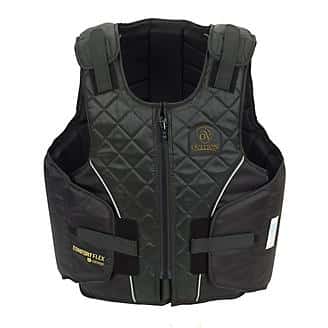
The Ovation Adult Comfort Flex Body Protector is an ideal semi-soft shell body protector for adult riders. The flexible design provides a wide range of movement, while the padded core meets SEI-ASTM and Beta level 3 protection. It is CE level 3 certified.
Pros
- Non-restrictive fit for comfort and flexibility
- Easy front zip design with a YKK zipper
- Side panels, shoulders, and front panels are adjustable to ensure a custom fit
- Made from 100% polyester and fully washable in cold water
Cons
- In warm conditions, the body protector becomes quite stifling
- It can take some time to dry
- Limited protection (especially compared to an air vest)
The Ovation body protector is a great introduction to body protective devices. It’s got a fair price, which means it’s in range of most riders’ budgets. It’s important to understand that wearing this body protector doesn’t make you a superhero, so don’t take unnecessary risks—a fall will still hurt.
And for younger riders, the Ovation Kids Comfort Flex Body Protector is also available.
Buy from Stateline Tack | Buy on Amazon
Best Solid Foam Body Protector for Eventing: Tipperary Eventer Pro
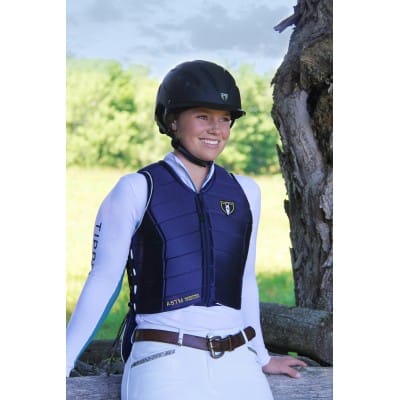
The Tipperary Eventer Pro Protective Vest is highly rated with ASTM|SEI certification. Tectonic foam plating provides a semi-hard shell vest that is impact resistant for great protection of the rider’s vital areas during falls.
Pros
- High shock absorption and impact resistance
- Form fitting flex cut for greater range of movement over jumps and rider comfort
- The side features a unique lace-up system for the ultimate custom fit
- Hardwearing outer is ideal for those wet and muddy jumps and involuntary dismounts
- Available in four colors, from black to hunter green and navy blue
Cons
- Limited protection of the neck and pelvis
I like the look and feel of the Eventer Pro vest, as it is lightweight and fits each rider perfectly due to the lace-up sides. However, I am still concerned about neck safety during a fall as there is no neck piece for the vest.
Buy at HorseLoverz.com | Buy on Amazon
Best Budget Body Protector Vest: UNISTRENGH Equestrian Vest
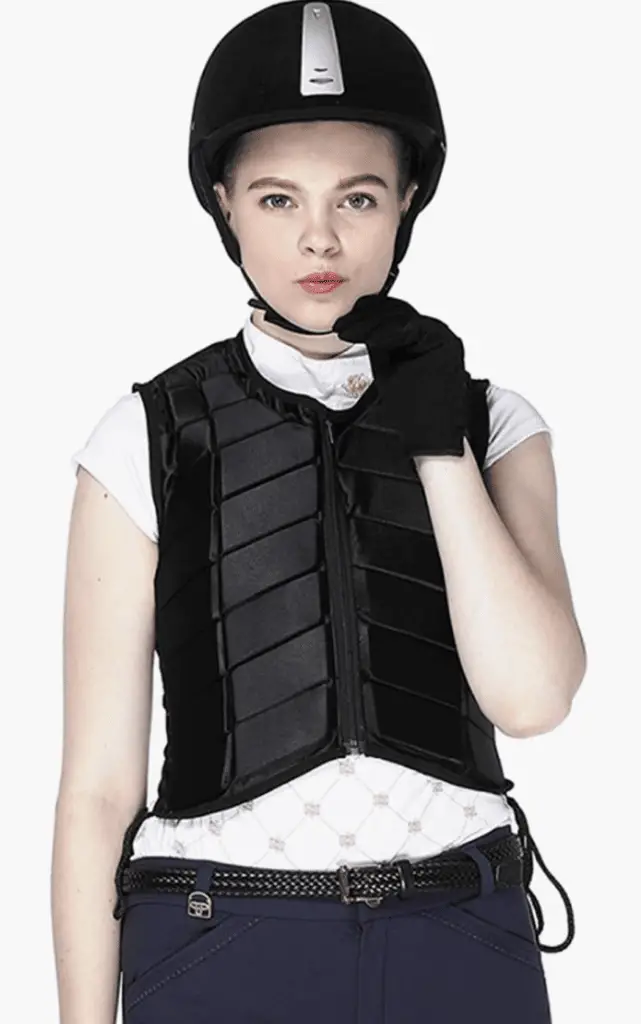
Okay, so if you’re on a really tight budget, you may not even look at anything over a hundred bucks, but some protection is better than no protection, right? The UNISTRENGH Equestrian Vest Professional Safety EVA Padded Horse Riding Vest is a great budget buy.
The vest is lightweight, form following, and functional. Unlike some other vests that are kind of cumbersome and feel like a tortoise shell, the UNISTRENGTH vest is shaped enough to be comfortable, and it also offers moderate protection from a fall.
Pros
- Zippered front closure and side lacings for a close contact fit
- Scalloped front for greater movement while riding, while the extended back section protects the lower back
- Available in five sizes, from small to 2XXL
- Very budget friendly
Cons
- Laces aren’t the best design and can come undone if not double knotted
- No sizing guide, so getting the right size may be an issue
Despite not carrying an official rating from an equestrian association, this vest has many riders raving. While this is probably not going to cut it at professional events or the upper echelons of riding, it is a great introduction for amateur riders.
Best Air Vest Body Protector: Hit-Air Original
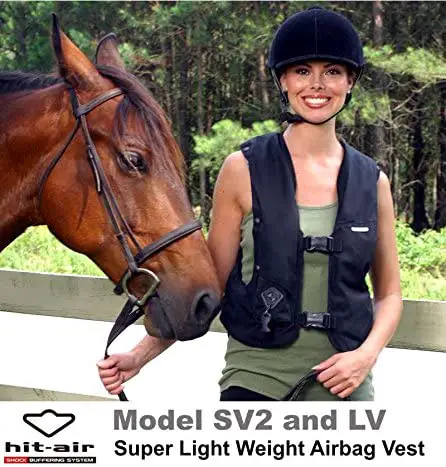
The Hit-Air Original vest is completely deflated when you wear it, only inflating when an impact occurs. (So no, you won’t look like a German sausage while you wear the vest!)
Pros
- One of the most protective vests you can buy
- Easy clasp closure
- Ventilated design to allow the vest to breathe better in hot conditions
- Neatly hidden canister and lanyard pouch
- Replacement canisters mean you can use the vest several times
Cons
- Canisters need to be ordered, though many of the other air vest brands carry similar canisters
- Needs to be worn as per manufacturer’s instructions to avoid serious injury
- Can be a more expensive investment
Despite the cost, I am an absolute convert to the air vest body protector. I am no longer nervous of my flighty mare and her unanticipated time-warps.
Horse Riding Safety Equipment FAQs
I’m sure you have questions… I know I did when I got my first riding safety equipment! Here are a few popular ones to help you out.
What is the difference between a body protector and an air vest?
Body protectors are padded vests that cushion the rider from the impact of a fall, dispersing the energy load that comes from the impact throughout the padding. Air vests create a much thicker layer of air around the rider’s body when they fall, dispersing energy more and preventing direct contact with the ground.
Both are body protecting devices, and you can even wear both together for high-impact equestrian sports.
Who should wear a body protector when riding?
Every rider, no matter the type of riding you do, should wear some form of body protection. Horse riding is a dangerous activity, and riders have been seriously hurt even in a walk. At some point, your body will no longer forgive you for the falls you’ve had, and a vest can help mitigate that somewhat.
So I’ve got a body protector… What other gear should I get to ensure I ride safely?
Other equestrian protective gear include a quality riding helmet that is new and fall-free. Yep, you should replace your helmet after any falls where your head impacted the ground. The impact of the helmet hitting the ground decreases its efficacy for the next time.
You can also look at getting good quality boots with reinforced toe caps to protect your toes from being stood on, gloves to prevent chafing and scrapes when you fall, and an air vest to double up on protection and further protect your neck and spine.
The Final Word on the Best Protective Vest for Horseback Riding
Horseback riding is a sport that is enjoyable but also dangerous. Riding without wearing some protection is not wise. A protective riding vest is a great way to ensure your falls are less serious and that you can remain more confident when riding because you know you are protected.
Your horse riding gear needs to include these basics:
- A horse riding helmet (with a three point harness)
- A body protector (either a padded horse riding safety vest or an air vest or both)
- Good quality riding boots
Happy and safe riding!
